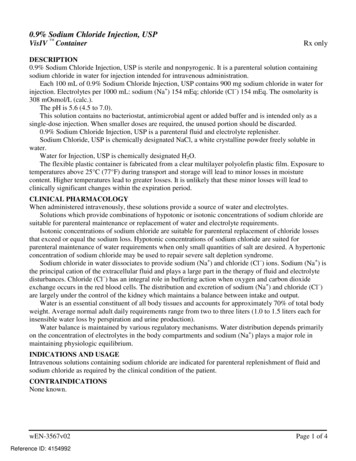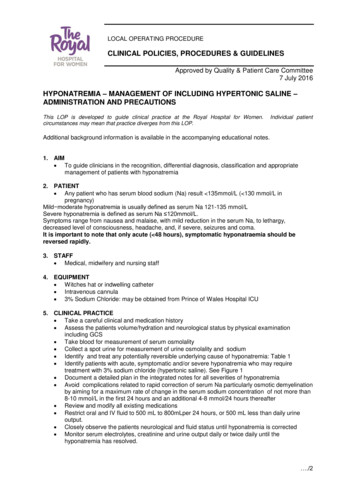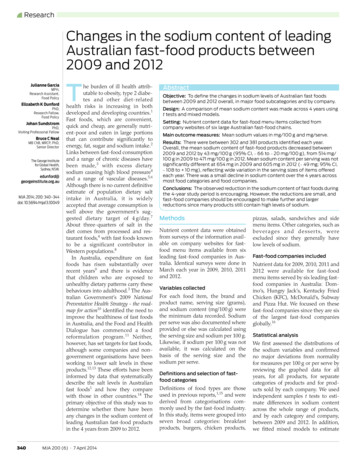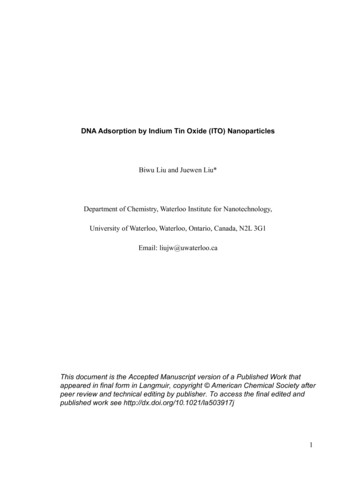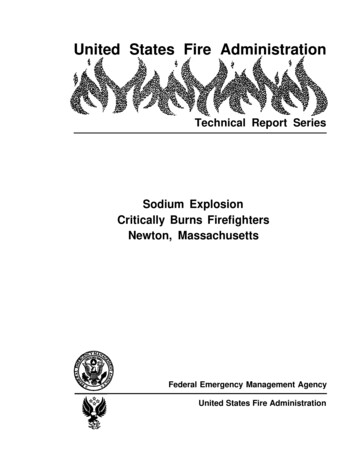
Transcription
United States Fire AdministrationTechnical Report SeriesSodium ExplosionCritically Burns FirefightersNewton, MassachusettsFederal Emergency Management AgencyUnited States Fire Administration
United States Fire Administration Fire Investigations ProgramThe United States Fire Administration develops reports on selected major fires throughout thecountry. The fires usually involve multiple deaths or a large loss of property. But the primary criterion fordeciding to do a report is whether it will result in significant “lessons learned.” In some cases these lessonsbring to light new knowledge about fire - the effect of building construction or contents, human behavior infire, etc. In other cases, the lessons are not new but are serious enough to highlight once again, with yetanother fire tragedy report.The reports are sent to tire magazines and are distributed at national and regional fire meetingsThe International Association of Fire Chiefs assists USFA in disseminating the findings throughout the fireservice. On a continuing basis the reports are available on request from USFA; announcements of theiravailability are published widely in fire journals and newslettersThis body of work provides detailed information on the nature of the fire problem for policymakerswho must decide on allocations of resources between fire and other pressing problems, and within the fireservice to improve codes and code enforcement, training, public fire education, building technology, andother related areasThe Fire Administration, which has no regulatory authority, sends an experienced fire investigatorinto a community after a major incident only after having conferred with the local fire authorities to insurethat USFA’s assistance and presence would be supportive and would in no way interfere with any review ofthe incident they are themselves conducting. The intent is not to arrive during the event or even immediatelyafter, but rather after the dust settles, so that a complete and objective review of all the important aspects ofthe incident can be made. Local authorities review USFA’s report while it is in draft. The USFAinvestigator or team is available to local authorities should they wish to request technical assistance for theirown investigation.This report and its recommendations were developed by USFA staff and by TriData Corporation,Arlington, Virginia, its staff and consultants, who are under contract to assist the Fire Administration incarrying out the Fire Reports Program.The United States Fire Administration greatly appreciates the cooperation received from Fire ChiefJoseph S. Daniele and Captain Joseph La Croix of the Newton, Massachusetts, Fire Department; TrooperJames Bradbury of the Office of the State Fire Marshal; and Steve Coan, Director of the MassachusettsFirefighting Academy.For additional copies of this report write to the United States Fire Administration, 16825 SouthSeton Avenue, Emmitsburg, Maryland 21727.
Sodium Explosion Critically Burns FirefightersInvestigated by:J. Gordon RoutleyLocal Contact:Fire Chief Joseph S. DanieleNewton Fire Department1164 Newton StreetNewton, MA 02159(617) 552-7272OVERVIEWEleven firefighters were burned, six seriously, one critically, and oneextremely critically, in an explosion that occurred while they wereattempting to extinguish a sodium fire in a metals processing establishmentin Newton, Massachusetts on October 25, 1993. The incident illustrateshow quickly and unpredictably an apparently minor hazardous materialssituation can change, with tragic consequences. It also shows how standardprotective clothing and equipment, designed for structural fire fighting, isdangerously inadequate for a molten metals incident.The situation was caused by a deviation from standard proceduresfor handling waste sodium at the facility. The incident provides animportant series of lessons for all firefighters on the risks involved withsodium and other flammable metals and on the need to obtain reliableinformation from responsible individuals at hazardous materials incidents.Fires in sodium and other water reactive metals are uncommon, andthe circumstances of this incident are particularly unusual. Previousexperience and pre-fire planning at the facility contributed to a false senseof security among the firefighters, who believed that the incident could behandled easily and without significant risk. Employees at the facility didnot provide information that would have caused the officers in charge ofthe incident to more fully evaluate the risks of this particular situationbefore initiating action.Page 1
SUMMARY OF KEY ISSUESCommentsEmployees deviated from standardprocedures by attempting to dispose of anexcessive amount of residual sodium. Thesodium overflowed and came in contact withwater causing an explosion and fire.Second ExplosionA second explosion occurred whenfirefighters were attempting to extinguish theresidual fire from the first explosion. Thefirefighters were splashed with burningmolten sodium.CasualtiesEleven firefighters burned, two very critically,six others seriously. Two plant employeeswere also injured.Risk AssessmentThe hazards of burning liquid sodium exceedthe capabilities of the fire department.There is an extreme risk of explosion,extinguishing agents are ineffective, andprotective clothing is inadequate.Additional HazardThe use of the same enclosure to performwet washing and to bum-off excess sodiumcreated an unnecessary hazard. Sodiumshould never be handled in a location wherethere is any possibility of contact with water.Action PlanResponding fire department personnel werenot provided with essential information thatshould have been considered in thedevelopment of an action plan. A fullevaluation of the risks and potentialconsequences of this incident would haveresulted in the conclusion that the safe planwould have been to take no action.Structural ProtectiveStructural protective clothing and selfcontained breathing apparatus are notClothingdesigned to provide adequate protection forexposure to molten metal. There is nopractical protective clothing for this hazard.IssuesCause of ExplosionPage 2
SUMMARY OF KEY ISSUESIssuesCommentsProper Use ofMembers involved in the incident wouldProtective Clothinghave been better protected if they had beenwearing full protective clothing ensemblesthat meet current standards and had usedthe chin straps on their helmets, pulled up3/4 length boots, and (in one case) not worna turnout coat without the liner.CommunicationsWith ambulance radios set to police(dispatch) channel, heavy radio trafficinterfered with the Incident Commandergetting them into the scene to transport bumvictims.Molten MetalBums caused by molten metal are moresevere than other types of bums, because themetal is extremely hot and impregnatesprotective clothing.The objective of the United States Fire Administration, in preparingthis report, and of Chief Joseph Daniele of the Newton Fire Department inrequesting the participation of the U.S. Fire Administration in theinvestigation, is to share the lessons that were learned so that similarpainful and tragic situations can be avoided in the future. The actions thatwere taken prior to and during this incident have been analyzed in greatdetail to determine what went wrong.The analysis, which was conducted with the luxury of time andaccess to all available information and expertise, indicates that the actionthat was taken involved a high level of risk and resulted in the situationthat is described. It must be recognized that these resources were notavailable to the individuals who had to face the situation as it waspresented to them at the time. This report should not be interpreted as acriticism of the decisions that were made or the actions that were taken.NEWTONNewton is a suburb located immediately to the west of Boston,Massachusetts. Newton is primarily a residential community withapproximately 80,000 residents, although it has significant commercial andbusiness areas and a relatively small industrial area. The communityincludes some very affluent areas, as well as a mixture of other residentialneighborhoods. The main campus of Boston College and several smallereducational institutions are also located in Newton.Page 3
The Newton Fire Department has 199 career personnel, operatingseven engine companies and three truck companies, with an Assistant Chiefon duty at all times. All of the companies operate with four member crewsduring the winter months; however, the engine companies often operatewith three crew members in the warmer months.The Newton Fire Department is headed by Chief Joseph S. Danieleand includes its own Fire Prevention Bureau and Communications Center.Newton takes an active part in MetroFire, the mutual aid system thatcovers Boston and 35 surrounding jurisdictions. The Newton FireCommunications Center serves as the primary mutual aid coordinatingcenter for the MetroFire system. Newton also participates in the regionalhazardous materials team with several of the other MetroFire jurisdictions.The Boston Fire Department operates an additional hazmat team to servethe central city, and the two teams provide backup for each other.Emergency medical service in Newton is provided by a privateambulance company, under the direction of the Police Department.Advanced life support ambulances are stationed at two fire stations but aredispatched by the Police Department. The Fire Department does notroutinely respond to EMS calls, unless they involve rescue or extrication.The ambulance company serves several communities in the area and hasunits deployed at several additional locations around Newton.LOCATION OF THE INCIDENTThe facility where the incident occurred is located in an industrialarea in the southern part of the city. The complex consists of several onestory brick industrial buildings on a crowded site. The particular buildingwhere the incident occurred is toward the back of the complex. The siteplan and building plan appear on the following pages. Several “high tech’companies have their manufacturing and processing facilities in theimmediate area.The incident occurred at a plant operated by H. C. Starck, Inc., amultinational company that produces a wide range of products. Thefacility in Newton produces items manufactured from tantalum, a raremetal that is used for components that require exceptionally high strengthand temperature resistance. The tantalum parts are used in assembliessuch as jet engines and nuclear reactors.Tantalum is shipped to the H. C. Starck facility as a salt, tantalumchloride, which must be converted to an extremely high grade metallic statebefore it can be molded and machined into finished products. Sodium isPage 4
used in the process as a reducing agent; the tantalum is converted from thesalt compound to a pure metal and the metallic sodium is converted to anon-hazardous salt compound (sodium chloride). The reaction takes placein a closed system and all of the by-products are retained for otherindustrial uses.The facility is reported to have an exceptionally good relationshipwith the Newton Fire Department. The plant has a full-time safetyspecialist, who maintains a close liaison with the Newton Fire Department,and the company is involved with the Local Emergency PlanningCommittee for hazardous materials incidents. All of the Newton FireDepartment companies that respond to the plant had been givenfamiliarization tours and were provided with information on the hazards ofmaterials used at the plant, including extinguishing procedures for minorsodium fires. Employees are also trained to handle minor sodium fires.There had been some incidents involving sodium at the facility inthe past. The Newton Fire Department had responded to some of theseincidents, which were handled with no unusual problems. Large containersof sodium chloride are located in areas where sodium is handled for use asan extinguishing agent.SODIUMSodium is classified as a hazardous material, primarily because of itsextreme reactivity when it comes in contact with water and many othersubstances.’ (See Appendix A for the Sodium MSDS Sheet and othermaterial on its properties, uses, storage, and handling.) Because of itsreactivity, sodium is seldom encountered in the pure metallic state, exceptwhen it is being used in an industrial process or for some extremely specialapplication. It must be shipped in sealed containers, because it will reacteven with the moisture in the air on a humid day.Sodium is a constituent of several non-hazardous compounds thatare in common use, such as table salt (sodium chloride) and severalpharmaceutical products. The metallic form of sodium is used inapplications that require unusual heat transfer and electrical conductivity1EI duPont is the only remaining producer of sodium in the United States. The demandfor sodium has decreased significantly in recent years due to the switch from regular gasolineto unleaded gasoline as a motor fuel. Sodium was used in the production of tetraethyl lead,an important additive in regular gasoline. Sodium is also used as a coolant in some nuclearreactors and particularly in experimental breeder reactors. For additional information onsodium, readers should contact EI duPont at (800) 441-9372.Page 7
properties. Pure sodium is encountered more frequently, however, as anagent in the processing of other substances. It is an extremely powerfulreducing agent, with the ability to strip oxygen atoms and other atoms ormolecules from otherwise stable molecules. These reactions usually releaselarge amounts of energy and additional chemical by-products are oftencreated, some of which are hazardous in themselves.Sodium is most widely recognized for its violent reaction with water.Pure sodium will break apart water molecules, separating the hydrogenatoms from the oxygen atoms. The sodium combines with the oxygen andliberates the hydrogen. The oxidation of the sodium is a combustionprocess, in which the sodium burns with a yellow flame to produce an ash(sodium oxide), which is liberated as a dense white acrid smoke. Thehydrogen is released as a gas, which usually explodes in the air as thehydrogen recombines with oxygen from the ambient atmosphere.In addition to creating sodium oxide and hydrogen gas, contact withmoisture can create sodium hydroxide, a corrosive liquid, which can causecorrosion bums to exposed skin.The power of sodium to break apart other compounds that containoxygen atoms and/or atoms with similar properties to oxygen make it anextremely valuable reducing agent with numerous applications in theprocessing of other materials. Sodium is a solid at normal ambienttemperatures but melts at the relatively low temperature of 208 degreesFahrenheit. Above 208 degrees, it can be transferred and mixed with othersubstances as a liquid, however, it must be kept in a closed system becauseit will auto-ignite in air at temperatures only slightly above its meltingtemperature. Liquefied sodium flows easily, with a viscosity similar towater.Once ignited, sodium is very difficult to extinguish. It will reactviolently with water, as noted previously, and with any extinguishing agentthat contains water. It will also react with many other commonextinguishing agents, including carbon dioxide and the halogen compoundsand most dry chemical agents. The only safe and effective extinguishingagents are completely dry inert materials, such as Class D extinguishingagents, soda ash, graphite, diatomaceous earth, or sodium chloride, all ofwhich can be used to bury a small quantity of burning sodium and excludeoxygen from reaching the metal.The extinguishing agent must be absolutely dry, as even a trace ofwater in the material can react with the burning sodium to cause anexplosion. Sodium chloride is recognized as an extinguishing mediumPage 8
because of its chemical stability, however it is hydroscopic (has theproperty of attracting and holding water molecules on the surface of thesalt crystals) and must be kept absolutely dry to be used safely as anextinguishing agent. Every crystal of sodium chloride also contains a tracequantity of moisture within the structure of the crystal.Molten sodium is extremely dangerous because it is much morereactive than a solid mass. In the liquid form, every sodium atom is freeand mobile to instantaneously combine with any available oxygen atom orother oxidizer, and any gaseous by-product will be created as a rapidlyexpanding gas bubble within the molten mass. Even a minute amount ofwater can create this type of reaction. Any amount of water introducedinto a pool of molten sodium is likely to cause a violent explosion insidethe liquid mass, releasing the hydrogen as a rapidly expanding gas andcausing the molten sodium to erupt from the container.When molten sodium is involved in a fire, the combustion occurs atthe surface of the liquid. An inert gas, such as nitrogen or argon, can beused to form an inert layer over the pool of burning liquid sodium, but thegas must be applied very gently and contained over the surface. Except forsoda ash, most of the powdered agents that are used to extinguish smallfires in solid pieces or shallow pools will sink to the bottom of a moltenmass of burning sodium -- the sodium will float to the top and continueto bum. If the burning sodium is in a container, it may be feasible toextinguish the fire by placing a lid on the container to exclude oxygen.Most municipal fire departments rarely, if ever, come in contactwith pure sodium, particularly molten sodium, in any significant quantities.It is shipped in sealed containers and can only be used under extremelycontrolled conditions in closed industrial processes. It is most often usedwithin large industrial complexes, where municipal fire departments areunlikely to become involved with it. Industries that use sodium must beextremely careful with it, because of the consequences of using it unsafely;many have plant fire brigades trained to handle small sodium incidents.It is also used in high energy/high temperature systems as a heattransfer medium. In this application it may be encountered at somenuclear power facilities and in experimental installations that are involvedin high energy power generation and transmission.DISPOSAL OF WASTE SODIUMThe pure sodium is shipped to the plant in Newton in 55 gallonsteel drums, each of which contains 400 lbs. of reactor grade (more thanPage 9
99.9 percent pure) sodium metal in a fused (solid) state. The solid mass ofsodium occupies all but a few inches at the top of the drum and theremaining space is filled with argon, an inert gas, to avoid contamination ofthe product in transit or storage.To extract the sodium, the steel drum is placed in a special heaterjacket that warms the contents until the sodium liquefies. A bayonet pickup tube is then inserted into the drum and additional inert gas isintroduced at the top of the drum, to displace the liquefied sodium. Thesodium is drawn up into the tube and directly into the closed processingsystem. The entire process takes place in a sealed atmosphere, since eventhe moisture and other contaminants in the outside ambient air cancontaminate the sodium, creating a risk of explosion and making itunusable for the process.The normal procedure is to extract all of the sodium from the drum,sometimes over a period of several days, down to the point that it can nolonger be drawn into the pick-up tube. This usually leaves two to fivepounds of sodium at the bottom of the drum which is allowed to cool andsolidify after the tube is withdrawn. The residual sodium, referred to as a“heel,” usually occupies less than l/2 inch at the bottom of the drum. Thisamount of sodium is impractical to extract or recycle; burning-off is acommon practice in the industry to dispose of small quantities of residualsodium.Burning-off the residual sodium avoids having to dispose of thedrums as a hazardous waste. This is practical, because the sodium can becompletely consumed and converted to sodium oxide ash, which iscollected by a filter system and can be disposed of much more easily. Theplant routinely has several drums with residual sodium to bum off eachweek. The task is usually performed during the second or third shift.The waste sodium is burned-off in a special enclosure that was builtfor cleaning drums. The room is approximately 8 ft. X 10 ft., with anexhaust system built into the roof to draw out the smoke. The burningsodium produces large quantities of smoke which is passed through ascrubber system to capture the sodium oxide ash and prevent atmosphericcontamination. The room has concrete block walls, with a large blowoutexplosion relief panel in the exterior wall to allow the force of an explosionto be vented to the outside. The blowout panel consists of a plywoodsheet, held in place by a metal framework.The access to the enclosure is a double doorway opening into amaintenance area of the plant. The doors are “blast doors” reinforced toPage 10
stay closed while the force of an explosion is directed to the outsidethrough the blowout panel, instead of through the doorway to the interiorof the plant.In addition to being designed for the disposal of waste sodium, theroom was also designed for wet washing drums and equipment that hadcontained other products and other items used in the process. Spraynozzles are located in one part of the room and the floor is a heavy metalgrate, which allows any runoff to drain into a system of shallow troughsthat lead to a holding tank and waste treatment system. Drums andequipment can be placed in the room and flushed, with all runoff drainingdown through the grates and into the troughs. There is often residualwater under the floor grates, after the room has been used for wet washing.To bum-off a sodium drum, the near-empty drum is placed in aspecial cradle that sets it at a slight angle inside the room (diagramappears on the following page). The cradle has a rocker end to allow thedrum to be tilted from a vertical position to an almost horizontal position.A metal drip pan is placed under the drum cradle to catch anything thatmight drip out of the drum and keep it from contacting the floor grates orfalling into the troughs. The top of the drum is completely removed andthe drum is positioned with the open end facing toward the blast doors.After the blast doors are closed and secured with a vertical bar, aworker ignites the sodium with a MAPP gas lance, which is insertedthrough an access hole in the blast doors and directly into the drum. Anyresidual sodium coating the sides of the drum is melted and forms a poolat the low end of the drum. When the sodium is ignited, the lance isremoved and the product is allowed to bum itself out, which usually takesone to two hours. The sodium first melts and forms a puddle in the lowend of the drum, then the liquid usually bums calmly with a glowing redcombustion.The burning sodium sometimes sputters and emits small flares ofglowing metal which are contained within the room. A heavy gray/whitesmoke is produced, which is drawn immediately up into the exhaust systemand out through the scrubbers. When the sodium is completely burned-outand the drum has cooled, it can be removed and sent out for disposal as anon-hazardous waste.Page 11
INCIDENT HISTORYOn the afternoon of October 25, 1993, a drum in the heater jacketwas allowed to cool before all of the sodium had been extracted. Due to amathematical error by the operator, approximately 100 lb. of sodium,almost one quarter of the drum’s capacity, was left in the drum when theheaters were turned off. The resolidified mass of sodium could not bereheated and drawn into the processing system, because it had beencontaminated by contact with outside air.The company’s standard operating procedures contained detailedspecific instructions on how to bum-off the sodium residue from a drum,anticipating that less than 10 pounds of residue would have to be burnedoff. There was no reference to guide employees on disposal of a large heelof sodium.Similar situations were reported to have happened occasionally inthe past and caused major problems for the employees responsible fordisposal of the drums. On one occasion, several months earlier, they hadused a chipping hammer to chip the sodium out of the barrel and bum itoff in small quantities. The chipping-out process was labor intensive andtime consuming and, when the sodium was chipped out, the chips came incontact with the sweaty skin of the worker. This caused painful bums asthe sodium reacted with his perspiration. They had decided to dosomething different if it happened again. The alternatives are to dispose ofthe drum as hazardous waste or to return it to the original supplier forrecycling.On the night of October 25, the night shift supervisor advised theworker who handled the drums that they had another drum with a largequantity of residual sodium and they were going to try burning it off,following the normal disposal procedure. They anticipated that it wouldtake longer, possibly all night to bum this quantity of sodium.The room had been used earlier in the evening to wash a reactorhead and the floor grates were reported to be damp when the drip pan wasplaced on top of them. The pan, which is leaned against the wall of theroom when it is not in use, is also believed to have been wet when it waslaid on top of the floor grates and there may have been water under thegrates.The drum was removed from the process area and transported tothe disposal room where the top was removed. When it was attempted toplace the drum in the cradle, the mass of solid sodium at the bottom wouldPage 13
not allow it to sit in the normal near-horizontal position; a metal agitatorshaft was used as a strut to keep it from tilting back to the upright position.The braced drum was placed in the normal position for burning, on top ofthe drip pan with the open end toward the door.Shortly after the sodium was ignited with the MAPP gas lance, theworker looked through a viewing port and noted that the fire was creatingmuch more smoke than usual. He also noted within a few minutes that thesolid sodium was liquefying and creating a liquid pool that was quicklyfilling the deep end of the drum. He became concerned and summonedthe supervisor who had directed him to bum the drum in this manner.Moments later, as the supervisor and two employees were discussingpossible courses of action, they noted that the liquid level was almost up tothe lip of the drum at the open end and the heavy smoke was filling theburnroom. A few seconds later an explosion occurred inside the burnroomthat shook the area and knocked them off their feet. Although the blastdoors held closed, some flecks of burning sodium were expelled throughthe openings in the door and struck the two of the plant personnel, causingminor bums. White smoke filled the immediate area and began to spreadto other parts of the building. All three employees evacuated the area,assisted by other plant personnel. The injured personnel were treated forminor bums by other employees.FIRE DEPARTMENT RESPONSEThe Newton Fire Department received box 6237, the alarm boxlocated at the front door of the building, at 2131 hours. As the box wasbeing transmitted, the first of several telephone calls was received,reporting an explosion and fire with injuries at the plant. The details givenby callers were incomplete and conflicting; however, the assignment wasupgraded from the regular response (two engines, one truck, and acommand officer) to the full building fire response, which adds an enginecompany from the neighboring Town of Needham. An additional Newtonengine company was also dispatched as the 4th due engine company on thefull box assignment. All responding units were advised of the reports of afire and explosion with injuries.The Newton Police Department, which dispatches the privateambulance company that serves the city, also received reports indicating anexplosion with injuries. Two ambulances and several police cars weredispatched to the scene.Page 14
The first companies to arrive reported smoke coming from thebuilding but no evidence of a major fire or explosion damage. Engines 7and 3, Ladder 2, and Car 2, the on-duty Assistant Chief, took positions inthe parking area near the front entrance to the building and made contactwith several employees who described the situation. There was noparticular employee who appeared to be in charge or to be specificallyresponsible for providing information to the fire department. The shiftsupervisor had been injured in the initial explosion and was being treatedby other employees.The employees advised that the material on fire was sodium, thatapproximately 100 pounds of sodium was involved, and emphasized that itwas important not to use water on it or to allow it to come in contact withwater. The employees also advised that salt should be used as theextinguishing agent. The firefighters were not advised that there could bewater in the area from the previous wet washing operation.Note: Sodium chloride is used as an extinguishing agent at this plant, becauselarge quantities of pure dry sodium chloride are used for metal processing andthe company keeps plenty on hand at all times. Large salt containers,designated for fighting combustible metals fires, are distributed around theplant. Scoops to apply the salt are kept in the containers, under a lid that isdesigned to exclude moisture.These salt containers could be moved around on wheeled dollies and broughtto the area where the material was burning. Additional quantities of baggedsalt were stored in another area of the plant and could be used as a backupsupply.The Assistant Chiefs Aide, accompanied by a plant employee, madean initial reconnaissance entry to the fire area, which was approximately200 feet back into the building. He was able to get close enough to o
Newton Fire Department 1164 Newton Street Newton, MA 02159 (617) 552-7272 Eleven firefighters were burned, six seriously, one critically, and one extremely critically, in an explosion that occurred while they were attempting to extinguish a sodium fire in a metals processing establishment in Newton, Massachusetts on October 25, 1993.



